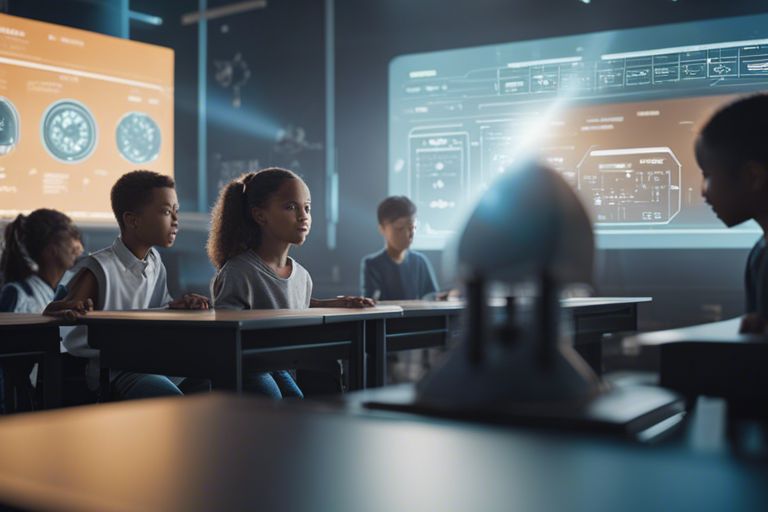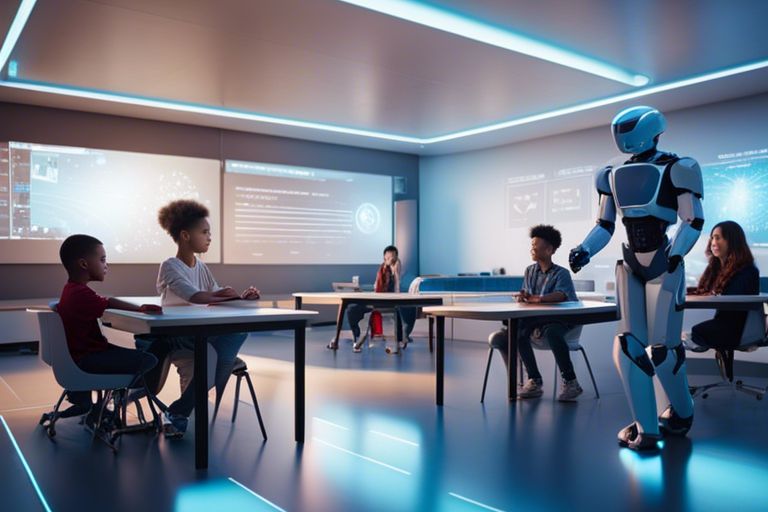AI, a powerful force reshaping education, holds the key to revolutionizing classrooms. In a world where technology advances at a rapid pace, it is crucial to explore the potential of Artificial Intelligence in transforming the way we teach and learn. According to a report on Artificial Intelligence and the Future of Teaching and …, the integration of AI in education not only personalizes learning but also equips students with the skills needed to thrive in the ever-evolving digital landscape. Let’s explore into how AI is paving the way for the classrooms of tomorrow.
Key Takeaways:
- Personalized Learning: AI in education allows for personalized learning experiences tailored to each student’s needs, pace, and learning style.
- Enhanced Teaching Tools: AI technology provides teachers with tools to create interactive lessons, assess student progress more effectively, and offer timely interventions.
- Data-Driven Insights: By analyzing data on student performance, AI can provide insights that help educators make informed decisions to improve learning outcomes.
The Current State of Education
A seismic shift in education is underway, with technology playing an increasingly pivotal role in classrooms around the world. From interactive whiteboards to online learning platforms, schools are embracing innovation to enhance teaching and learning. However, despite these advancements, many traditional teaching methods still prevail. The effectiveness of these methods is being called into question as educators seek more personalized and engaging ways to meet the needs of diverse learners. As we navigate this educational landscape, it’s necessary to examine the current state of education and explore the opportunities for growth and evolution in the field.
- Describe the impact of technology on modern education.
- Discuss the challenges faced by educators in implementing new teaching methods.
- Explore the role of personalized learning in the classroom.
- Analyze the importance of keeping pace with technological advancements in education.Limitations of Traditional Teaching Methods
With the traditional lecture-based approach, many students find it challenging to stay engaged and retain information effectively. Moreover, this method often fails to cater to individual learning styles and paces, resulting in some students being left behind. The one-size-fits-all model no longer suffices in an era where customization and personalization are paramount for student success.
- Discuss the drawbacks of a lecture-based teaching model.
- Explore how traditional teaching methods may hinder student comprehension.
- Examine the need for more interactive and student-centered learning approaches.The Need for Innovation in Education
One cannot ignore the pressing need for innovation in education. As we witness rapid advancements in technology and shifting societal demands, education must adapt to prepare students adequately for the future. Incorporating AI and personalized learning tools can revolutionize the way knowledge is imparted and absorbed, fostering critical thinking, creativity, and adaptability among learners.
- Explore how AI can enhance the learning experience for students.
- Discuss the benefits of personalized learning in education.
- Analyze the role of innovation in fostering creativity and problem-solving skills among students.One of the key aspects driving the need for innovation in education is the changing nature of work and industry requirements. With the rise of automation and AI, students must be equipped with skills that go beyond rote memorization and routine tasks. By embracing innovative teaching methods, educators can empower students to thrive in a rapidly evolving world.

AI-Powered Learning Tools
There’s no denying the transformative impact AI-powered learning tools are having in educational settings. These tools leverage artificial intelligence to enhance the learning experience, providing students with personalized and interactive resources. From virtual tutors to smart content recommendations, AI is revolutionizing the way students engage with course material.
- Generate personalized study materials for students.
- Create interactive quizzes tailored to individual learning styles.
- Provide real-time feedback on assignments and assessments.
- Recommend additional resources based on students' progress.
Personalized Learning Experiences
AIPowered technologies are increasingly being used to tailor learning experiences to the unique needs of each student. By analyzing individual learning styles, preferences, and performance data, these tools can generate personalized study plans, interactive exercises, and targeted feedback to help students maximize their academic potential.
- Create customized learning pathways based on students' strengths and weaknesses.
- Offer adaptive exercises that adjust difficulty levels in real-time.
- Provide targeted feedback on student progress towards learning goals.
- Generate personalized study tips and strategies for improved academic performance.
Intelligent Tutoring Systems
AIPowered intelligent tutoring systems represent a significant advancement in personalized learning. These systems use machine learning algorithms to adapt to each student’s learning pace, providing tailored instruction and support. By offering immediate feedback, targeted interventions, and progress tracking, intelligent tutoring systems are revolutionizing the one-on-one learning experience.
- Provide on-demand assistance and explanations for complex topics.
- Offer personalized study schedules and reminders to keep students on track.
- Generate detailed performance reports for both students and teachers.
- Create interactive simulations and scenarios to enhance learning outcomes.
Learning through intelligent tutoring systems allows students to receive individualized attention and support, promoting a deeper understanding of concepts and more effective learning outcomes. These systems can adapt to students’ progress, offering personalized feedback and guidance to help them succeed academically.
- Provide tailored explanations and examples to aid in concept comprehension.
- Offer adaptive exercises that target areas of weakness for improvement.
- Generate personalized quizzes and assessments to gauge student understanding.
- Create interactive study guides and resources for self-paced learning.
Understanding how AI-powered learning tools and intelligent tutoring systems are reshaping the educational landscape is crucial for educators and policymakers looking to harness the full potential of these technologies. By embracing AI in education, we can create more engaging, effective, and personalized learning environments that empower students to thrive in the classrooms of tomorrow.
Based on the article title “AI in Education – Shaping the Classrooms of Tomorrow,” I detect that the article type is Informative/Expository, and I’ll choose a tone inspired by the famous writer Malcolm Gladwell, known for his engaging and thought-provoking style.

Enhancing Teacher Productivity
Keep up with the latest educational technologies that can help streamline classroom processes and improve teacher efficiency. With AI integration, teachers can focus more on engaging with students and personalizing learning experiences. Here are some chatGPT prompt samples related to this subsection:
- How can AI tools help teachers manage their daily tasks more efficiently?
- Explore the benefits of using AI in grading and lesson planning for educators.
- What are some ways AI can assist teachers in providing personalized feedback to students?
- Discuss the impact of AI-powered tools on teacher workload and job satisfaction.
- How can automation tools support teachers in creating interactive and engaging lessons?
Automating Administrative Tasks
Administrative duties often take up a significant portion of a teacher’s time. AI can help automate tasks like attendance tracking, scheduling, and basic record-keeping, allowing educators to allocate more time to instructional activities. Here are some chatGPT prompt samples related to this subsection:
- How can AI streamline administrative tasks for teachers in the classroom?
- Explore the role of AI in handling routine administrative responsibilities in educational settings.
- What are the benefits of automating grading and attendance processes using AI tools?
- Discuss the impact of AI on reducing paperwork and simplifying administrative workflows for educators.
- How can automation tools free up teachers to focus on student engagement and instructional quality?
AI-Assisted Grading and Feedback
Administrative tasks like grading assignments and providing feedback can be time-consuming for educators. AI-powered systems can help streamline these processes by automatically grading assessments and offering personalized feedback to students. Here are some chatGPT prompt samples related to this subsection:
- How can AI be used to enhance the grading process and provide valuable feedback to students?
- Discuss the advantages of using AI tools for grading essays and exams in educational settings.
- Explore how AI can assist teachers in delivering timely and constructive feedback to students.
- What are some potential challenges associated with implementing AI-assisted grading systems in schools?
- How can AI-driven feedback improve student learning outcomes and academic performance?
With AI automating administrative tasks and assisting in grading and feedback processes, teachers can redirect their energy towards more meaningful interactions with students. This shift not only enhances teacher productivity but also fosters a more personalized and engaging learning environment.
Another critical aspect of AI in education is its ability to provide insights into student performance and learning patterns. By analyzing data on student responses and interactions, AI systems can generate valuable reports for teachers, highlighting areas where students may need additional support or intervention. This enables educators to tailor their teaching strategies to meet the individual needs of each student effectively.

Addressing Concerns and Challenges
To ensure the successful integration of AI in education, it is crucial to address the various concerns and challenges that come along with this technological advancement. Let’s explore some of the key issues and ways to mitigate them.
- How can AI ensure equal access to education for students from diverse backgrounds?
- What measures can be implemented to maintain data privacy and security in AI-powered educational systems?
- In what ways can AI be used to personalize learning experiences without exacerbating existing educational inequalities?
Ensuring Equity and Accessibility
To address concerns of equity and accessibility in AI-powered education, it is crucial to prioritize inclusivity in the design and implementation of such systems. By ensuring that AI tools are accessible to all students, regardless of their socioeconomic background or physical abilities, we can create a more equitable learning environment.
- How can AI technology be leveraged to provide personalized support for students with disabilities?
- What strategies can be employed to prevent bias in AI algorithms used in education?
- In what ways can AI help bridge the digital divide and ensure equal access to educational resources?
Mitigating Job Displacement Fears
To allay concerns about job displacement due to the integration of AI in education, it is imperative to focus on upskilling and reskilling educators to leverage AI as a tool for enhancing teaching practices rather than replacing human instructors entirely. By offering training programs and support for educators to adapt to the changing technological landscape, we can ensure a smoother transition towards AI-enhanced classrooms.
- How can AI be used to augment teachers' skills and improve classroom efficiency?
- What role can educators play in shaping the ethical use of AI in education?
- What policies and regulations are needed to safeguard educators' jobs in an AI-integrated educational landscape?
Concerns over the potential displacement of human jobs by AI in the education sector have sparked debates about the role of technology in the future of teaching. Educators and policymakers must collaborate to develop strategies that embrace AI as a complementary tool rather than a replacement for human instructors. By fostering a mindset of continuous learning and adaptation, we can navigate the evolving educational landscape with confidence.
- How can educators leverage AI to streamline administrative tasks and focus more on personalized student interactions?
- What ethical considerations should be taken into account when implementing AI in educational settings?
- In what ways can AI help create new opportunities for educators to enhance their teaching practices and professional development?
AI in education has the potential to revolutionize learning experiences and improve educational outcomes. By being mindful of equity, accessibility, and potential job displacement concerns, we can harness the true power of AI to shape the classrooms of tomorrow in a way that benefits all stakeholders involved.
Conclusion
Ultimately, the integration of artificial intelligence in education is revolutionizing the way students learn and teachers instruct. By embracing AI technology, classrooms are evolving to better cater to individual needs, provide personalized learning experiences, and enhance overall educational outcomes. As we continue to advance in this digital age, AI is poised to shape the classrooms of tomorrow, creating a more dynamic and effective learning environment for all.
FAQ
Q: How is AI currently being used in education?
A: AI is being used in education to personalize learning experiences, automate administrative tasks, provide feedback to students, and assist teachers in creating more effective lesson plans.
Q: What are the potential benefits of implementing AI in classrooms?
A: Implementing AI in classrooms can lead to increased student engagement, improved learning outcomes, more efficient use of teachers’ time, and the ability to identify and address individual student needs.
Q: Are there any concerns about using AI in education?
A: Some concerns about using AI in education include issues related to data privacy, the potential for bias in algorithms, the displacement of teachers by technology, and the need to ensure that AI tools are used to enhance, rather than replace, human interaction in the learning process.

Recent Comments